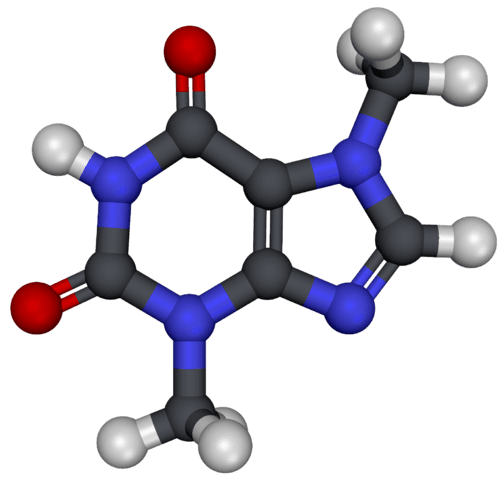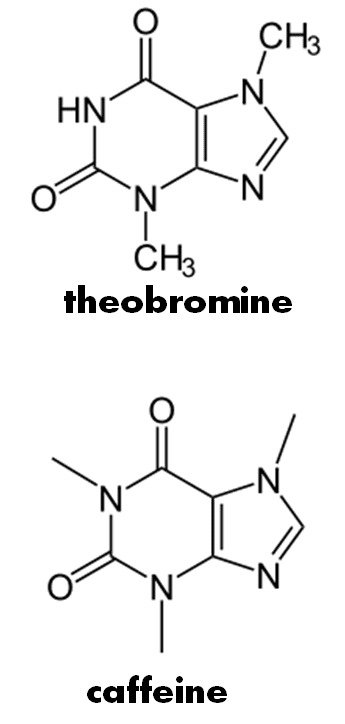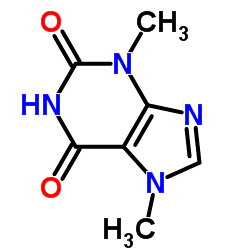Routes ofadministration Oral Formula C7H8N4O2 Molar mass 180.164 g/mol | Biological half-life 7.1±0.7 hours CAS ID 83-67-0 | |
 | ||
ATC code C03BD01 (WHO) R03DA07 (WHO) Legal status In general: uncontrolled Metabolism Excretion Renal (10% unchanged, rest as metabolites) | ||
Theobromine chocolate molecule keychain pendant
Theobromine, formerly known as xantheose, is a bitter alkaloid of the cacao plant, with the chemical formula C7H8N4O2. It is found in chocolate, as well as in a number of other foods, including the leaves of the tea plant, and the kola (or cola) nut. It is classified as a xanthine alkaloid, which also include the similar compounds theophylline and caffeine. The compounds differ in that caffeine has an extra methyl group (see under #Pharmacology).
Contents
- Theobromine chocolate molecule keychain pendant
- Therapeutic uses
- Pharmacology
- Humans
- Animals
- Gene mutation in mammalian cells
- References

Despite its name, the compound contains no bromine—theobromine is derived from Theobroma, the name of the genus of the cacao tree, (which itself is made up of the Greek roots theo ("god") and broma ("food"), meaning "food of the gods" with the suffix -ine given to alkaloids and other basic nitrogen-containing compounds.

Theobromine is a slightly water-soluble (330 mg/L), crystalline, bitter powder. Theobromine is white or colourless, but commercial samples can be yellowish. It has an effect similar to, but lesser than, that of caffeine in the human nervous system, making it a lesser homologue. Theobromine is an isomer of theophylline, as well as paraxanthine. Theobromine is categorized as a dimethyl xanthine.

Theobromine was first discovered in 1841 in cacao beans by Russian chemist Alexander Voskresensky. Synthesis of theobromine from xanthine was first reported in 1882 by Hermann Emil Fischer.

Therapeutic uses

Theobromine is a vasodilator (a blood vessel widener), a diuretic (urination aid), and heart stimulant. It is not currently used as a medicinal drug.

Theobromine increases urine production. Because of this diuretic effect, and its ability to dilate blood vessels, theobromine has been used to treat high blood pressure. The American Journal of Clinical Nutrition notes that historic use of theobromine as a treatment for other circulatory problems including arteriosclerosis, certain vascular diseases, angina pectoris, and hypertension should be considered in future studies.
Following its discovery in the late 19th century, theobromine was put to use by 1916, when it was recommended by the publication Principles of Medical Treatment as a treatment for edema (excessive liquid in parts of the body), syphilitic angina attacks, and degenerative angina.
In the human body, theobromine levels are halved between 6–10 hours after consumption.
Theobromine has also been used in birth defect experiments involving mice and rabbits. A decreased fetal weight was noted in rabbits following forced feeding, but not after other administration of theobromine. Birth defects were not seen in rats. Possible future uses of theobromine in such fields as cancer prevention have been patented.
Theobromine has also been shown to improve the microhardness of tooth enamel which could potentiality increase resistance to tooth decay.
Pharmacology
Even without dietary intake, theobromine may occur in the body as it is a product of the human metabolism of caffeine, which is metabolised in the liver into 12% theobromine, 4% theophylline, and 84% paraxanthine.
In the liver, theobromine is metabolized into xanthine and subsequently into methyluric acid. Important enzymes include CYP1A2 and CYP2E1.
Like other methylated xanthine derivatives, theobromine is both a:
- competitive nonselective phosphodiesterase inhibitor, which raises intracellular cAMP, activates PKA, inhibits TNF-alpha and leukotriene synthesis, and reduces inflammation and innate immunity and
- nonselective adenosine receptor antagonist.
As a phosphodiesterase inhibitor, theobromine prevents the phosphodiesterase enzymes from converting the active cAMP to an inactive form. cAMP works as a second messenger in many hormone- and neurotransmitter-controlled metabolic systems, such as the breakdown of glycogen. When the inactivation of cAMP is inhibited by a compound such as theobromine, the effects of the neurotransmitter or hormone that stimulated the production of cAMP are much longer-lived. In general, the net result is a stimulatory effect.
Humans
The amount of theobromine found in chocolate is small enough that chocolate can, in general, be safely consumed by humans. Theobromine poisoning may result from the chronic or acute consumption of large quantities, especially in the elderly.
Theobromine and caffeine are similar in that they are related alkaloids. Theobromine is weaker in both its inhibition of cyclic nucleotide phosphodiesterases and its antagonism of adenosine receptors. Therefore, theobromine has a lesser impact on the human central nervous system than caffeine. Theobromine stimulates the heart to a greater degree. While theobromine is not as addictive, it has been cited as possibly causing addiction to chocolate. Theobromine has also been identified as one of the compounds contributing to chocolate's reputed role as an aphrodisiac.
As it is a myocardial stimulant as well as a vasodilator, it increases heartbeat, and also dilates blood vessels, causing a reduced blood pressure. A 2005 paper published suggested that the decrease in blood pressure may be caused by flavanols. Its draining effect allows it to be used to treat cardiac failure, which leads to and is exacerbated by an excessive accumulation of fluid in the body.
A 2004 study published by Imperial College London concluded that theobromine has an antitussive (cough-reducing) effect superior to codeine by suppressing vagus nerve activity. In the study, 1,000 milligrams (0.035 oz) theobromine (equivalent to ~71 grams (2.5 oz) dark chocolate) significantly increased the threshold of capsaicin concentration required to induce coughs when compared with a placebo. A drug, called BC1036, is being developed by the private UK company infirst Healthcare and it uses theobromine to treat persistent cough. Theobromine is helpful in treating asthma, since it relaxes the smooth muscles, including the ones found in the bronchi.
A study conducted in Utah between 1983 and 1986, and published in 1993, showed a possible association between theobromine and an increased risk of prostate cancer in older men. This association was not found to be linear for aggressive tumors. The association may be spurious, but is plausible. Prenatal and infant exposure to theobromine appeared possibly associated with hypospadias and testicular cancer in one population study.
As with caffeine, theobromine can cause sleeplessness, tremors, restlessness, anxiety, as well as contribute to increased production of urine. Additional side effects include loss of appetite, nausea, vomiting, and withdrawal headaches.
Animals
Animals that metabolize theobromine (found in chocolate) more slowly, such as dogs [1], can succumb to theobromine poisoning from as little as 50 grams (1.8 oz) of milk chocolate for a smaller dog and 400 grams (14 oz), or around nine 44-gram (1.55 oz) small milk chocolate Hershey bars, for an average-sized dog. It should be observed the concentration of theobromine in dark chocolates (approximately 10 g/kg (0.16 oz/lb)) is up to 10 times that of milk chocolate (1 to 5 g/kg (0.016 to 0.080 oz/lb)) - meaning dark chocolate is far more toxic to dogs per unit weight or volume than milk chocolate.
The same risk is reported for cats as well, although cats are less likely to ingest sweet food, with most cats having no sweet taste receptors. Complications include digestive issues, dehydration, excitability, and a slow heart rate. Later stages of theobromine poisoning include epileptic-like seizures and death. If caught early on, theobromine poisoning is treatable. Although not usual, the effects of theobromine poisoning, as stated, can become fatal.
In 2014, four American black bears were found dead at a bait site in New Hampshire. A necropsy and toxicology reports performed at the University of New Hampshire in 2015 confirmed they died of heart failure caused by theobromine after they consumed 41 kilograms (90 lb) of chocolate and doughnuts placed at the site as bait. A similar incident killed a black bear cub in Michigan in 2011.
The toxicity for birds is not known, but it is typically assumed that it is toxic to birds.
Gene mutation in mammalian cells
Theobromine is known to induce gene mutations in lower eukaryotes and bacteria. In 1991 and 1997, research by the International Agency for Research on Cancer had shown that genetic mutations occurred in higher eukaryotic cells, specifically cultured mammalian cells. Despite this, theobromine is still listed as safe for human consumption due to inadequate evidence of carcinogenicity.
